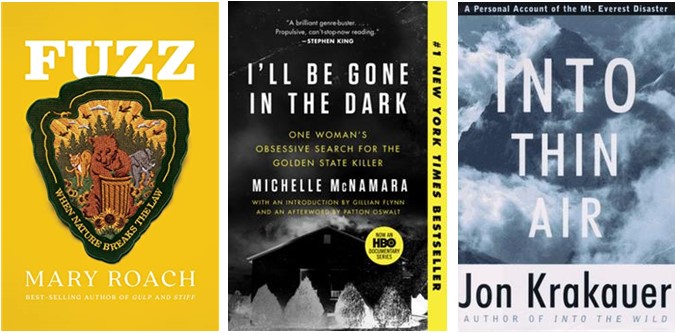“Narrative nonfiction” is nonfiction that tells a story. In other words, nonfiction that reads like fiction. Other nonfiction is more “task oriented” – like cookbooks, diet books or home repair books. I like the idea of a continuum of narrative – ranging from “highly narrative works” that read like a novel to “less narrative,” more technical works.
In 1965 Truman Capote created a sensation when he published In Cold Blood: A True Account of a Multiple Murder and Its Consequences – the story of the murder of a family in Kansas. Some people say that this is the first example of narrative nonfiction, sometimes called creative nonfiction. Capote called it a “nonfiction novel”. It was a departure from previous nonfiction works, as it gave a vivid depiction of events – the two murderers meeting, the murder itself, etc. I would argue that there were earlier examples of this genre – they just didn’t receive the attention that Capote’s did: A Night to Remember by Walter Lord – classic account of the final hours of the Titanic published in 1955 and Endurance: Shackleton’s Incredible Voyage by Alfred Lansing 1957. Lansing’s book was popular when it was first published, then drifted out of print – until it was discovered and republished in the 1980s. This is a fantastic story of British explorer Ernest Shackleton’s attempt to reach the South Pole in 1914.
Since the publishing of those important nonfiction works, there has been a surge in the popularity of similar works. Many writers have taken up the challenge to write exciting nonfiction.
Readers who are fans of certain nonfiction writers will read whatever they write about – they have a dedicated fan base. For example: Mary Roach (Fuzz: When Animals Break the Law; Gulp: Adventures in the Alimentary Canal and many others) Laura Hillenbrand (Seabiscuit: An American Legend; Unbroken: A World War II Story of Survival, Resilience and Redemption), Erik Larson (The Devil in the White City: Murder, Magic, and Madness at the Fair that Changed America; Dead Wake: The Last Crossing of the Lusitania; and others) or Bill Bryson (Walk in the Woods; The Body: A Guide for Occupants and others).
Here are some great narrative nonfiction titles:
Exploration
Endurance: Shackleton’s Incredible Voyage by Alfred Lansing (org 1959)
The saga of polar explorer Ernest Shackleton’s survival for over a year on the ice-bound Antarctic seas. Alfred Lansing’s scrupulously researched book has long been acknowledged as the definitive account of the Endurance‘s fateful trip. To write their authoritative story, Lansing consulted with ten of the surviving members and gained access to diaries and personal accounts by eight others.
Undaunted Courage: Meriwether Lewis, Thomas Jefferson and the Opening of the American West by Stephen Ambrose (1996)
A chronicle of the two-and-a-half year journey of Lewis and Clark covers their incredible hardships and the contributions of Sacajawea.
River of the Gods: Genius, Courage and Betrayal in the Search for the Source of the Nile by Candace Millard (2022)
Set against the backdrop of the race to exploit Africa by the colonial powers, a story of courage and adventure brings to life the rivalry between two enemies—a decorated soldier and a young aristocrat/Army officer—as they set out to find the mysterious headwaters of the Nile River.
The Lost City of Z: A Tale of Deadly Obsession in the Amazon by David Grann (2009)
Interweaves the story of British explorer Percy Fawcett, who vanished during a 1925 expedition into the Amazon to find an ancient civilization, with the author’s own adventure-filled quest into the uncharted wilderness to uncover the mysteries surrounding Fawcett’s final journey and the secrets of what really lies deep in the Amazon jungle.
Science
Fuzz: When Nature Breaks the Law by Mary Roach (2021)
Join Mary Roach on an investigation into the unpredictable world where wildlife and humans meet. As she discovers, the answers are best found not in jurisprudence but in science: the curious science of human-wildlife conflict, a discipline at the crossroads of human behavior and wildlife biology.
The Body: A Guide for Occupants by Bill Bryson (2019)
Bill Bryson guides us through the human body–how it functions, its remarkable ability to heal itself, and (unfortunately) the ways it can fail. Full of facts and Bryson-esque anecdotes, The Body will lead you to a deeper understanding of the miracle that is life in general and you in particular.
The Immortal Life of Henrietta Lacks by Rebecca Skloot (2010)
Race, poverty and science intertwine in the story of the woman whose cancer cells were cultured without her permission in 1951 and have supported a mountain of research undertaken since then.
True Crime
In Cold Blood: A True Account of a Multiple Murder and Its Consequences by Truman Capote (1965)
An account of the apparently senseless 1959 murders of four members of a rural Kansas family and the search for and eventual execution of the two young killers.
I’ll Be Gone in the Dark: One Woman’s Obsessive Search for the Golden State Killer by Michelle McNamara (2018)
A masterful true crime account of the Golden State Killer– the elusive serial rapist turned murderer who terrorized California for over a decade– from Michelle McNamara, the gifted journalist who died tragically while investigating the case.
Killers of the Flower Moon: The Osage Murders and the Birth of the FBI by David Grann (2017)
In the 1920s, the richest people per capita in the world were members of the Osage Indian nation in Oklahoma. After oil was discovered beneath their land, they rode in chauffeured automobiles, built mansions, and sent their children to study in Europe. Then, one by one, the Osage began to be killed off. The family of an Osage woman, Mollie Burkhart, became a prime target. Her relatives were shot and poisoned. And it was just the beginning, as more and more members of the tribe began to die under mysterious circumstances.
Red Notice: A True Story of High Finance, Murder and One Man’s Fight for Justice by Bill Browder (2015)
A real-life political thriller about an American financier in the Wild East of Russia, the murder of his principled young tax attorney, and his dangerous mission to expose the Kremlin’s corruption.
Trailed::One Woman’s Quest to Solve the Shenandoah Murders by Kathryn Miles (2022)
An account of the unsolved murder of two women in Shenandoah National Park, by a journalist with unprecedented access to all key elements of the case, and a story that reveals the challenges of wilderness forensics and the failures of our justice system.
Adventure
Into Thin Air: A Personal Account of the Mount Everest Disaster by Jon Krakauer (1997)
The author describes his spring 1996 trek to Mt. Everest, a disastrous expedition that claimed the lives of eight climbers, and explains why he survived.
Shadow Divers: The True Adventure of Two Americans Who Risked Everything to Solve One of the Last Mysteries of World War II by Robert Kurson (2004)
Recounts the discovery of a sunken German U-boat by two scuba divers, tracing how they devoted the following years to researching the identities of the submarine and its crew, correcting historical texts and breaking new ground in the world of diving.
History
In the Heart of the Sea: The Tragedy of the Whaleship Essex by Nathaniel Philbrick (2000)
Recounts the story of the 1820 wreck of the whaleship Essex, which inspired Melville’s classic “Moby-Dick,” and describes its doomed crew’s ninety-day attempt to survive whale attacks and the elements on three tiny lifeboats.
Unbroken: A World War II Story of Survival, Resilience and Redemption by Laura Hillenbrand (2010)
On a May afternoon in 1943, an Army Air Forces bomber crashed into the Pacific Ocean and disappeared, leaving only a spray of debris and a slick of oil, gasoline, and blood. Then, on the ocean surface, a face appeared–Lt. Louis Zamperini. Captured by the Japanese and driven to the limits of endurance, Zamperini would answer desperation with ingenuity; suffering with hope, resolve, and humor.
Dead Wake: The Last Crossing of the Lusitania by Erik Larson (2015)
A 100th-anniversary chronicle of the sinking of the Lusitania that discusses the factors that led to the tragedy and the contributions of such figures as President Wilson, bookseller Charles Lauriat and architect Theodate Pope Riddle.
The Perfect Storm: A True Story of Men against the Sea by Sebastian Junger (1997)
It was the storm of the century, boasting waves over one hundred feet high―a tempest created by so rare a combination of factors that meteorologists deemed it “the perfect storm.” In a book that has become a classic, Sebastian Junger explores the history of the fishing industry, the science of storms, and the candid accounts of the people whose lives the storm touched. The Perfect Storm is a real-life thriller that makes us feel like we’ve been caught, helpless, in the grip of a force of nature beyond our understanding or control.
A Night to Remember: The Classic Account of the Final Hours of the Titanic by Walter Lord (1956)
First published in 1956 and born of 20 years’ research, this account of the voyage of the Titanic–and its aftermath–is a classic of detailed investigation.
Travel
Eat, Pray Love: One Woman’s Search for Everything across Italy, India, Indonesia by Elizabeth Gilbert (2006)
The celebrated author of The Last American Man creates an irresistible, candid, and eloquent account of her pursuit of worldly pleasure and spiritual devotion.
The Great Railway Bazaar: By Train through Asia by Paul Theroux (1975)
In 1973, Paul Theroux embarked on a four-month journey by train from the United Kingdom through Europe, the Middle East, and Southeast Asia. In The Great Railway Bazaar, he records in vivid detail and penetrating insight the many fascinating incidents, adventures, and encounters of his grand, intercontinental tour.
Blue Latitudes: Boldly Going Where Captain Cook has Gone Before by Tony Horwitz (2002)
Memoir
My Family and Other Animals by Gerald Durrell (1956)
Gerald Durrell’s hilarious account of five years in his childhood spent living with his family on the island of Corfu. With snakes, scorpions, toads, owls and geckos competing for space with one bookworm brother and another who’s gun-mad, as well as an obsessive sister, young Gerald has an awful lot of natural history to observe. This richly detailed, informative and riotously funny memoir of eccentric family life is a twentieth-century classic.
Educated by Tara Westover (2018)
Born to survivalists in the mountains of Idaho, Tara began to educate herself as a teenager, learning enough mathematics and grammar to be admitted to Brigham Young University. Her quest for knowledge would transform her, taking her over oceans and across continents, to Harvard and to Cambridge. Only then would she wonder if she’d traveled too far, if there was still a way home.
The Glass Castle: A Memoir by Jeanette Walls (2005)
The author recalls her life growing up in a dysfunctional family with an alcoholic father and distant mother and describes how she and her siblings had to fend for themselves until they finally found the resources and will to leave home.
Wild: From Lost to Found on the Pacific Crest Trail by Cheryl Strayed (2012)
Traces the personal crisis the author endured after the death of her mother and a painful divorce, which prompted her ambition to undertake a dangerous 1,100-mile solo hike that both drove her to rock bottom and helped her to heal.
If you need more reading recommendations, call us at 725-5242 – we are






